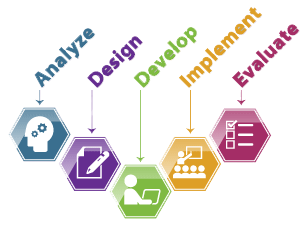
Our Approach
eLearning doesn’t just happen! It requires careful planning and implementation.In our world this is called Instructional Design (ID).The term Instructional Design refers to the systematic and reflective process of translating principles of learning and instruction into plans for instructional materials, activities, information resources, and evaluation.
The process consists broadly of determining the state and needs of the learner, defining the end goal of instruction, and creating some "intervention" to assist in the transition. Ideally, the process is informed by tested theories of learning and instruction and the outcome of this instruction may be directly observable. In plain words, presenting content in a simple, meaningful and effective way, is the art of good instructional design.
- Conduct a training needs analysis of the targeted group.
- Determine whether these needs can be fulfilled by learning and how exactly
- Work with Subject Matter Experts to identify what students need to learn
- Write learning objectives and ensures that content match those objectives.
- Choose the instructional strategies and training techniques appropriate for the training.
- Develop, revise or adapt (e.g. from face-to-face to eLearning) content to shape it for learning needs
- Structure content and activities for student learning
- Create media to support learning (e.g., visual aids for face-to-face, various multimedia for e-learning and online)
- Develop assessments (note that this does not only mean tests)
- Conduct formative and summative evaluation to content/instructional material. Review and revise where necessary.
All the above tasks can be standardized in an Instructional Systems Design (ISD) framework or model. ADDIE model is the most commonly used instructional design model and the go-to process most training designers use when crafting learning experiences. “ADDIE” stands for Analyze, Design, Develop, Implement, and Evaluate. The five phases that give ADDIE its name are the steps that should be followed to create training from start to finish. Let’s take a quick look at each step using one-sentence statements:

Analysis: Determining instructional goals and performance objectives.
Design: Creating a road-map for accomplishing the goals and objectives
Development: Creating the elements laid out in the design phase
Implementation: Deploying the training
Evaluation: Measuring whether the training works and goals have been achieved.

This sequence, however, does not impose a strict linear progression through the steps. There are many instructional design models (Dick & Carey, Kemp ISD models) - others follow a more agile approach (SAM ISD model) - but most of them are variations of the ADDIE process. ADDIE is a cycle. This means it is flexible enough to allow anyone, at anytime to revisit a step, and refine it.
Such an approach means that we are able to incorporate changes to your project without upsetting your budget or schedule. We are here to make things work for you without interfering with your business requirements and limitations.
It would be a great pleasure to work with you!
“29.1% of corporate training hours are delivered with blended learning methods”
“44% of companies intent to purchase online learning tools and systems.”
Tell us about your project
Let us help you get your business online and grow it with passion
Our team of professional eLearning experts is the perfect partner for a successful business partnership.
Statistics
See all testimonials“29.1% of corporate training hours are delivered with blended learning methods”
“44% of companies intent to purchase online learning tools and systems.”




